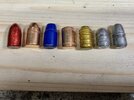Riomouse911
Member
Since the OP is a bit newer to loading .38 Special, I grabbed a few .358 bullets to show a few different ones.

L to R:
Eggleston 148 gr coated LRN
Extreme 158 gr plated target HPRN
Blue Bullets coated 158 gr SWC
Extreme plated 148 gr DEWC
All of these have a sharp-edged base.
Brazos 148 gr coated “button nose” wadcutter
Missouri (I think?) 125 gr lead RNFP
Eggleston 148 gr coated LRN
The three of these have a bevel base. Note the Eggleston round nose bullet on the far right, it has a pronounced bevel.
As was posted above, a decent flare is needed when loading a coated or plated bullet. If the edge of the case mouth catches the plating/coating, it will peel it off. This will leave a patch of bare lead on the bullet to smear in the bore when it’s fired.
Stay safe.

L to R:
Eggleston 148 gr coated LRN
Extreme 158 gr plated target HPRN
Blue Bullets coated 158 gr SWC
Extreme plated 148 gr DEWC
All of these have a sharp-edged base.
Brazos 148 gr coated “button nose” wadcutter
Missouri (I think?) 125 gr lead RNFP
Eggleston 148 gr coated LRN
The three of these have a bevel base. Note the Eggleston round nose bullet on the far right, it has a pronounced bevel.
As was posted above, a decent flare is needed when loading a coated or plated bullet. If the edge of the case mouth catches the plating/coating, it will peel it off. This will leave a patch of bare lead on the bullet to smear in the bore when it’s fired.
Stay safe.


